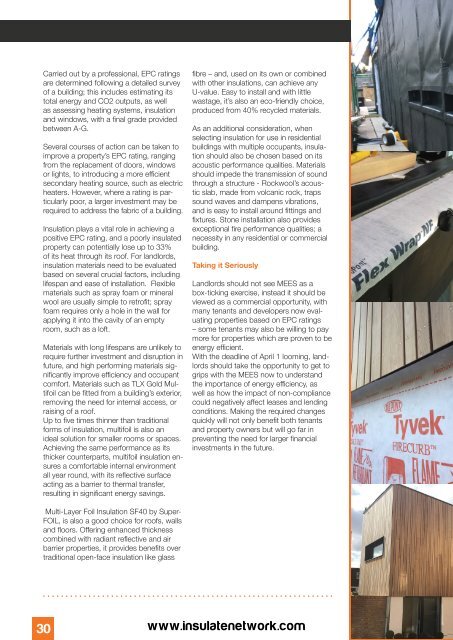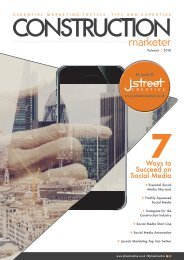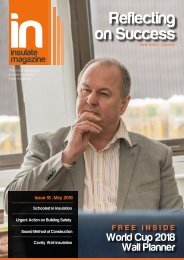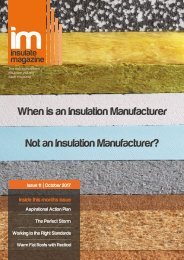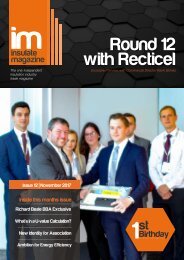Insulate Magazine - Essential Insulation Inside - March 2018 Issue 16
Insulate Insulation Magazine, Featuring articles on innovative new insulation products, grand design projects, captivating case studies, industry updates and exclusive articles. Essential publication for the construction industry
Insulate Insulation Magazine, Featuring articles on innovative new insulation products, grand design projects, captivating case studies, industry updates and exclusive articles. Essential publication for the construction industry
You also want an ePaper? Increase the reach of your titles
YUMPU automatically turns print PDFs into web optimized ePapers that Google loves.
Carried out by a professional, EPC ratings<br />
are determined following a detailed survey<br />
of a building; this includes estimating its<br />
total energy and CO2 outputs, as well<br />
as assessing heating systems, insulation<br />
and windows, with a final grade provided<br />
between A-G.<br />
Several courses of action can be taken to<br />
improve a property’s EPC rating, ranging<br />
from the replacement of doors, windows<br />
or lights, to introducing a more efficient<br />
secondary heating source, such as electric<br />
heaters. However, where a rating is particularly<br />
poor, a larger investment may be<br />
required to address the fabric of a building.<br />
<strong>Insulation</strong> plays a vital role in achieving a<br />
positive EPC rating, and a poorly insulated<br />
property can potentially lose up to 33%<br />
of its heat through its roof. For landlords,<br />
insulation materials need to be evaluated<br />
based on several crucial factors, including<br />
lifespan and ease of installation. Flexible<br />
materials such as spray foam or mineral<br />
wool are usually simple to retrofit; spray<br />
foam requires only a hole in the wall for<br />
applying it into the cavity of an empty<br />
room, such as a loft.<br />
Materials with long lifespans are unlikely to<br />
require further investment and disruption in<br />
future, and high performing materials significantly<br />
improve efficiency and occupant<br />
comfort. Materials such as TLX Gold Multifoil<br />
can be fitted from a building’s exterior,<br />
removing the need for internal access, or<br />
raising of a roof.<br />
Up to five times thinner than traditional<br />
forms of insulation, multifoil is also an<br />
ideal solution for smaller rooms or spaces.<br />
Achieving the same performance as its<br />
thicker counterparts, multifoil insulation ensures<br />
a comfortable internal environment<br />
all year round, with its reflective surface<br />
acting as a barrier to thermal transfer,<br />
resulting in significant energy savings.<br />
fibre – and, used on its own or combined<br />
with other insulations, can achieve any<br />
U-value. Easy to install and with little<br />
wastage, it’s also an eco-friendly choice,<br />
produced from 40% recycled materials.<br />
As an additional consideration, when<br />
selecting insulation for use in residential<br />
buildings with multiple occupants, insulation<br />
should also be chosen based on its<br />
acoustic performance qualities. Materials<br />
should impede the transmission of sound<br />
through a structure - Rockwool’s acoustic<br />
slab, made from volcanic rock, traps<br />
sound waves and dampens vibrations,<br />
and is easy to install around fittings and<br />
fixtures. Stone installation also provides<br />
exceptional fire performance qualities; a<br />
necessity in any residential or commercial<br />
building.<br />
Taking it Seriously<br />
Landlords should not see MEES as a<br />
box-ticking exercise, instead it should be<br />
viewed as a commercial opportunity, with<br />
many tenants and developers now evaluating<br />
properties based on EPC ratings<br />
– some tenants may also be willing to pay<br />
more for properties which are proven to be<br />
energy efficient.<br />
With the deadline of April 1 looming, landlords<br />
should take the opportunity to get to<br />
grips with the MEES now to understand<br />
the importance of energy efficiency, as<br />
well as how the impact of non-compliance<br />
could negatively affect leases and lending<br />
conditions. Making the required changes<br />
quickly will not only benefit both tenants<br />
and property owners but will go far in<br />
preventing the need for larger financial<br />
investments in the future.<br />
Multi-Layer Foil <strong>Insulation</strong> SF40 by Super-<br />
FOIL, is also a good choice for roofs, walls<br />
and floors. Offering enhanced thickness<br />
combined with radiant reflective and air<br />
barrier properties, it provides benefits over<br />
traditional open-face insulation like glass<br />
30 www.insulatenetwork.com


